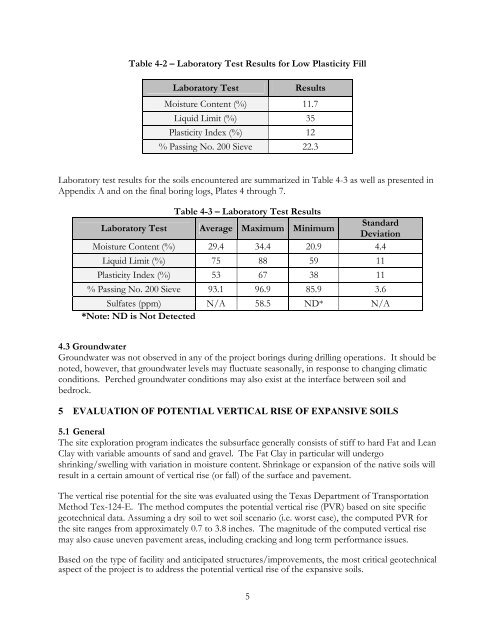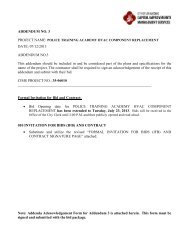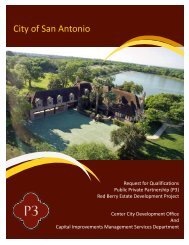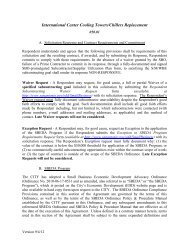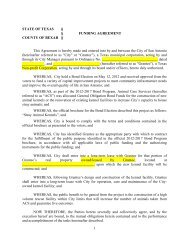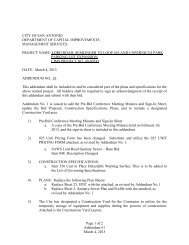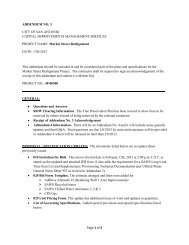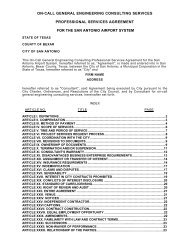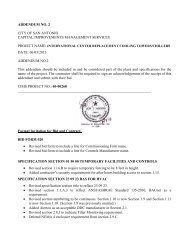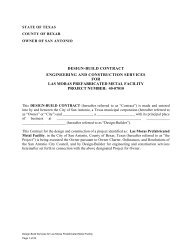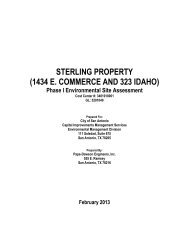Geotechnical Investigation Report - The City of San Antonio
Geotechnical Investigation Report - The City of San Antonio
Geotechnical Investigation Report - The City of San Antonio
- No tags were found...
You also want an ePaper? Increase the reach of your titles
YUMPU automatically turns print PDFs into web optimized ePapers that Google loves.
Table 4-2 – Laboratory Test Results for Low Plasticity Fill<br />
Laboratory Test<br />
Results<br />
Moisture Content (%) 11.7<br />
Liquid Limit (%) 35<br />
Plasticity Index (%) 12<br />
% Passing No. 200 Sieve 22.3<br />
Laboratory test results for the soils encountered are summarized in Table 4-3 as well as presented in<br />
Appendix A and on the final boring logs, Plates 4 through 7.<br />
Table 4-3 – Laboratory Test Results<br />
Laboratory Test Average Maximum Minimum<br />
Standard<br />
Deviation<br />
Moisture Content (%) 29.4 34.4 20.9 4.4<br />
Liquid Limit (%) 75 88 59 11<br />
Plasticity Index (%) 53 67 38 11<br />
% Passing No. 200 Sieve 93.1 96.9 85.9 3.6<br />
Sulfates (ppm) N/A 58.5 ND* N/A<br />
*Note: ND is Not Detected<br />
4.3 Groundwater<br />
Groundwater was not observed in any <strong>of</strong> the project borings during drilling operations. It should be<br />
noted, however, that groundwater levels may fluctuate seasonally, in response to changing climatic<br />
conditions. Perched groundwater conditions may also exist at the interface between soil and<br />
bedrock.<br />
5 EVALUATION OF POTENTIAL VERTICAL RISE OF EXPANSIVE SOILS<br />
5.1 General<br />
<strong>The</strong> site exploration program indicates the subsurface generally consists <strong>of</strong> stiff to hard Fat and Lean<br />
Clay with variable amounts <strong>of</strong> sand and gravel. <strong>The</strong> Fat Clay in particular will undergo<br />
shrinking/swelling with variation in moisture content. Shrinkage or expansion <strong>of</strong> the native soils will<br />
result in a certain amount <strong>of</strong> vertical rise (or fall) <strong>of</strong> the surface and pavement.<br />
<strong>The</strong> vertical rise potential for the site was evaluated using the Texas Department <strong>of</strong> Transportation<br />
Method Tex-124-E. <strong>The</strong> method computes the potential vertical rise (PVR) based on site specific<br />
geotechnical data. Assuming a dry soil to wet soil scenario (i.e. worst case), the computed PVR for<br />
the site ranges from approximately 0.7 to 3.8 inches. <strong>The</strong> magnitude <strong>of</strong> the computed vertical rise<br />
may also cause uneven pavement areas, including cracking and long term performance issues.<br />
Based on the type <strong>of</strong> facility and anticipated structures/improvements, the most critical geotechnical<br />
aspect <strong>of</strong> the project is to address the potential vertical rise <strong>of</strong> the expansive soils.<br />
5


